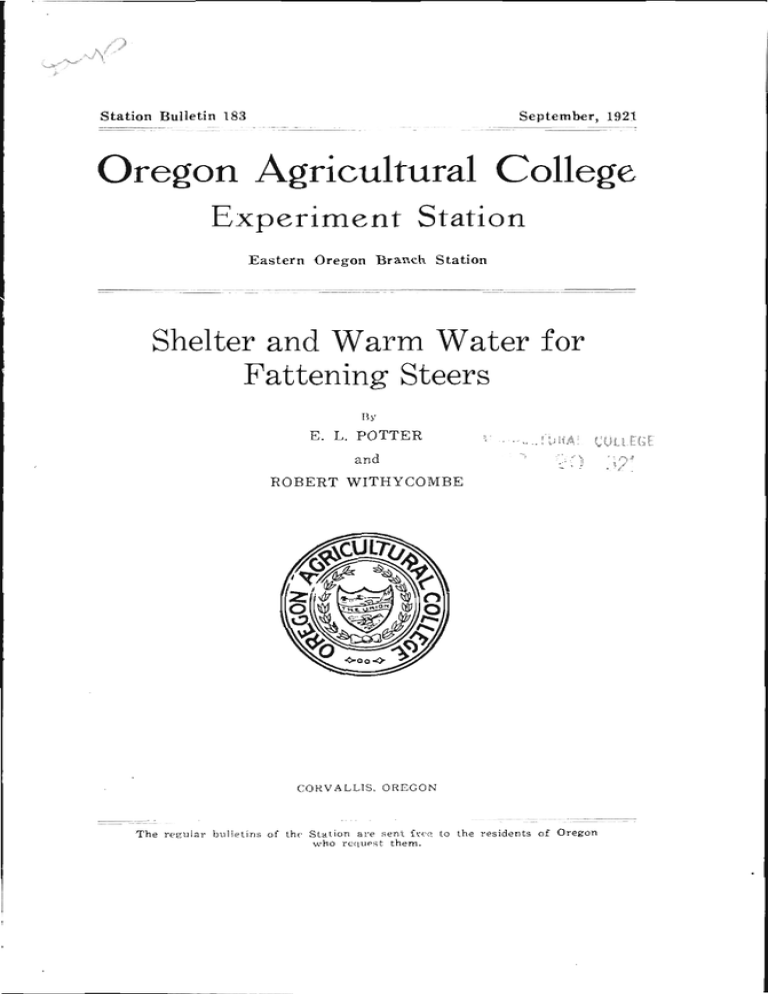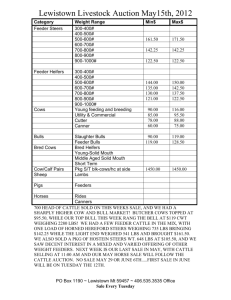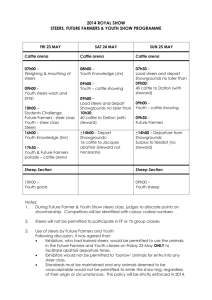Oregon Agricultural College Experiment Station Shefter and Warm Water for Fattening Steers
advertisement

Station Bulletin 183 September, 1921 Oregon Agricultural College Experiment Station Eastern Oregon Branch Station Shefter and Warm Water for Fattening Steers fly E. L. POTTER and ROBERT WITHYCOMBE CORVALLIS, OREGON The rguar buHetins of the Station are sent free to the residents of Oregon who request them. BOARD OF REGENrS OF THE OREGON AGRICULTURAL COLLEGE AND EXPERIMENT STATION Albany HON. J. K. WEATHERFORD, President HON. N. R. Moojuc, Secretary HON. B. F IRVINE, Treasurer HON. BEN W. OLcort, Governor HON. SAM A. KOzER, Secretary of State HON. J. A. CHURCHILL, Superintendent of Public Instruction HON. CHA.RLES E. SCENeS, Master of State Grange HON. C. L. HAWLEY HON. Warn M. PiRc HON. H. VON De HELLEN HON. GRO. M. CORNWALL HON. JEFFERSON MYKOS HON. M. S. WOODCOCK Corvallis Portland Salem Salem Salem Oregon City Portland LaGrande Wellen Portland Portland Corvallis STATION STAFF President J. T. JARDINE, U.S Director F. T. REED, 13.5., AFt Editor Plant Pathologist H. P. BAReS, A.B., SM P. M. BBANDT, ES. in Agri., A.M Dairy Husbandman A. C. BOUQUET, U.S Horticulturist (Vegetable Gardening) G. G. BROWN, B.S Horticulturist, Hood River Br. Exp. Station, Hood River W. S. BROWN, AS., MS Horticulturist in Charge D. E. BULLIs, £3.5 "issistant Chemist W. J. KgnR, D.Sc., LL.D Supt. hood River Branch Exp. Station, Hood River Bacteriologist Assistant in Soils (Drainage) Supt. Tjmatilla Branch Exp. Station, Hermiston *JAMES DRYDEN Poultry Husbandman E. ENGBRETSON, B.S Supt. John Jacob Astor Br. Exp. Station, Astoria B. FOLTON, B.A., M.S Associate Entomologist W. V. HALVERSEN, M.S Assistant Bacteriologist E. M. HARVEY, PH.D Hortieulturist (Physiology) G. R. HT5LOP, U.S Farm Crop Specialist W. W. JOHNSTON, U.S Assistant in Soils (Irrigation) J. S JONES, M.S Chemist F. C. JoNEs, B.S Associate Dairy Husbandman F. L. KNOWLTON, B.S Research Assistant in Poultry Husbandry F. H. LATHROP, AU., M.S Associate Entomologist J. C. LEWIS Farm Crop Foreman A. L. LOVETT, B.S. Entomologist A. G. LUNN, U.S Poultry Husbandman in Charge F. W. MILLER, MS., D.V.M Assistant Veterinarian *H. C. MILLER, M,S Associate Chemist G. A. MITCH5L, 13.S Asst. to Supt. of Sherman County Branch Station A. E. MURNERIC, MS Assistant Horticulturist (Physiology) M. B. MCKAY, M.S Associate Plant Pathologist 0. M. NELSON, U.S.A Associate Animal Husbandman J. R. NEVIUS, B.S Assistant Farm Crop Specialist A. W. OLIVER, B.S Assistant Animal Husbandman E. L. POTTER, MS Animal Husbandman W. L. POWERS, M.S Chief, Department of Soils *C K. POWELL, £3.5 Assistant Poultry Husbandman J. C. REEOER, 13.5 Assistant Chemist F. C. RElaTER, M.S Supt. Southern Oregon Br. Exp. Station, Talent D. W. RITCHIE, U.S Assistant in Soils (Irrigation) R. H. ROBINSON, M.S Associate Chemist C. C. RUTH, M.S Assistant Farm Crop Specialist C. V. RUZEIC, U.S Associate in Soils (Fertility) AGNES RYDER Scientific Asst. Seed Lab. U. S. Dept. of Agri. (Seed Analyst) H. A. SCHOTH, M.S U. S. Dept. of Agri. Scientific Asst. in Forage Crops C. E. SCHUSTEIT, U.S &ssistant Horticulturist (Pomology) H. £3. SC000ER, B.S Chief in Farm Management 0. SHATTUcK, M.S Supt Harney County Branch Exp. Station, Burns B. T. SIMMS, U.S., D.V.M Veterinarian D. B. STEPHENS, U.S Supt. Sherman County Br. Exp. Station, Moro K. S. TAYLOR, B.S Assistant in Soils E. F. T0RGERsON, U.S Assistant in Soils (Soils Survey.) E. H. WIEGAND, 13.5 4.ssistant Horticulturist (Horticultural Products) ROBERT WITHYCOMBE, B.S Supt. Eastern Oregon Br. Exp. Station, Union H. M. WOOLMAN, Field Asst., Office of Cereal Investigations, U. S. Dept. of Agri. C. H. WEBBER, 1.3.5 Asst. to Supt. of Umatilla Branch Experiment Station S. M. ZELLER, PH.D Associate Plant Pathologist *On leave of absence. LEROY CHIL0S, AFt C. V. CopsoN, M.S WARD CRETCHER, KS H. K. DEAN, B S SUMMARY Fattening steers, fed and sheltered in the barn and having access to a lot for exercise, consumed the same amount of feed and made very little more gains than those fed in the open. Fattening calves, given access to a shelter shed, consumed the same amount of feed and made the same gains as did those without the shed. Fattening steers, given water warmed to an average of 43 degrees, consumed the same amount of feed and made the same gains as did those which received cold water. _..;-. A -. fl - FEED LOTS AT EASTERN OREGON BRANCH EXPERIMENT STATION Shelter and Warm Water for Fattening Steers Very few fattening cattle in Eastern Oregon are ever fed during the winter months in a bleak, open feed lot without some sort of a shelter. This shelter may consist of o modern barn, an open shed, a prepared windbreak, or a brush thicket. Probably the latter is the most commonly used and is possibly the most feasible and practical for most farm conditions. A good brush thicket where cattle can always find shelter from storms and a good bed ground is a valuable asset to any feed yard. Another very important factor in cattle feeding is the water supply. Too often cattle are required to drink from muddy and inaccessible water holes, which freeze in winter, making it difficult for the cattle to drink at will. While all cattlemen will agree that feeding under such conditions cannot be expected to show profitable results, yet there is a LII Fir. 1. Barn and yard in which Lot 1 was fed. wide-spread belief among most feeders that even if water is supplied in a modern way, still better results might be expected if it were warmed for the cattle by the use of a tank heater. There is also an opinion that better results would he obtained if cattle were given better shelter facilities than are usually provided on most farms. Realizing what a good brush thicket means in this regard they wish to know further what might be expected if cattle were fed in an enclosure such as a barn. It was in the hope of shedding some light on these points that the following experiments were planned at the Union station. First, feeding two-year-old steers in a barn. Second, feeding calves in a lot provided with an open shed. Third, feeding two-year-old steers in a lot provided with warm water. The experiment staticn at Union is located in the Blue Mountain region at an altitude of 2787 feet; hence the conditions under which these 6 tests were conducted are quite typical of this particular region, and in fact represent in a fair degree the conditions under which a large percentage of the cattle are fed in the section of the State lying east of the Cascades. The weather during the winter months is usually quite cold and windy, though the minimum temperature rarely ever is lower than 10 degrees below zero. The ground usually remains frozen and the winds come mainly from the southeast during the major portion of the winter feeding period. The total snow fall is about 30 inches and is pretty well distributed through the months of December, January, February, and March. In the Grande Ronde Valley where the experiment station is located the snow as a rule does not lie on the ground long, but blows about and accumulates in large drifts. Fig. 2. Interior of barn in which Lot 1 was fed. Ten steers were quartered in this space 12x36. The rainfall is comparatively light during these months. The five- year average for the total fall from Decemb or to April inclusive 3.88 inches. is TABLE I. METEOROLOGICAL RECORD EXPERIMENT STATION, UNION, OREGON Five-year Avers e for Winter Feeding Period 1916-1921 inclusive Temperature--Month December January February March April Average for five. mo, :h period Max. 54 53 52 64 73 59 Precipitation - Mean Max. Mean Mm. Rain Spow 11 14 19 87.03 37.09 39.58 48.67 57.43 24.74 23.54 24.56 28.70 31.44 1.16 .76 .22 .49 1.25 4.58 7.50 6.17 8.4 2.9 9 43.96 26.60 .78 5.91 Mm. 5 -3 7 Feeder cattle as a rule do not make satisfactory gains when fed in the open during wet, muddy seasons, but seem to do best when weather conditions are dry and cold.. In this bulletin are given the results of three series of tests, which will be considered under the three divisions as stated above. In each case the data given are averages of two year's work. For shelter tests with lambs see Station Bulletin 175. SHELTER FOR FATTENING STEERS In the winter of 1919-20 and again in 1920-21 comparisons were made of shelter for fattening steers as compared with open-lot feeding. There were ten two-year-old steers in each lot. In the 1919-20 test the steers weighed 1200 pounds at the start and were fed for 82 days. In Fig. 3. Shed for wintering calves in Lot 2. the 1920-21 test the steers weighed 948 pounds at the start and were fed for 120 days. Both lots were fed on alfalfa hay and silage. In the first test corn silage and peas-and-bald-barley silage and alfalfa hay were fed, while in the second test sunflower silage and alfalfa hay were used. The steers in one lot were fed and sheltered in a space 12x36 in the barn and had access to an outside lot where they obtained water and exercise (see figures 1 and 2). Those in the second lot were fed in the open with no shelter other than a windbreak on the south and a tight board fence around the east end of the lot. A daily record was kept of the temperature of the barn and of the open lot. The average daily temperature in the barn was 42 degrees and in the open lot, 33 degrees, but of course the temperature of the open lot was more variable than that of the barn. The open lots were rather muddy a good share of the time, especially in the second test. The stream from which both lots obtained their drinking water was carried through the yards in a board 8 flume and was thus kept free from ice and in condition so that the steers could drink easily at all times (see Fig. 4). The feed consumption and daily gains for the two tests are averaged and shown in Table II. TABLE II. Hay per day Silage per day Daily gain AVERAGE OF 1919-20 AND 1920-21 TESTS Loti Lot2 shelter open lot 25.18 19.21 26.81 15.19 1.485 1.56 4r From the above it will be seen that the shelter increased the gains less than 1/10 pound daily. The lot under shelter ate more silage and a little less hay. At $8.00 a ton for hay and $5.00 a ton for silage the Fig. 4. Board flume from which all lots on cold water were watered. The flume is covered except where the steers drink. daily feed cost was 15 cents a day as compared with 14'/2 cents for the lot fed in the open. This difference in feed cost would offset the slight difference in gains. All of these differences, however, are so slight as to be within the limit of experimental error; hence it would seem on the basis of these two tests that the barn shelter made no material difference. With other types of shelter or under other conditions the results might have been different. In addition to the two tests given above, another lot in 1019-20 was fed and quartered in the barn without access to an outside lot. During the first few weeks of the test the cattle in this lot made very satisfactory gains, but toward the close of the experiment they appeared to grow stale; hence they did not make the final showing that the cattle did having an open lot for exercise or even those that were fed in the open. 9 SHELTER FOR CALVES In the winter of 1917-18 two lots of six calves each were fed on alfalfa, peas-and-bald-barley silage, and barley. One lot was fed in the open without shelter, the second lot received feed in the open but had access to the small shed shown in Fig. 3. These calves weighed 543 pounds at the start and were kept on feed for 112 days. In the winter of 1918-19 the test was repeated a ith calves weighing 490 pounds at the start and fed for 82 days. The feed consumption and the gains made in the two tests are averaged and shown in Table III. Fig. 5. Tank heater used to warm walr for Lot 2. Notr that the heater is enclosed to protect it from the stock hoL Lha, a door in the enclosure permits access to it. TABLE III. AVERAGE OF 1011-10 AND lOiS-tO TESTS Lot I Lot2 Fed Fed in the open with access to shed in the open Hay per day Silage per day Grain per day Daily gain 12.39 tO.26 5,09 1.90 11.64 10.26 5.03 Is? The differences between the two particular lots both as to feed consumption and daily gain are negligible, and there was no real difference in the final condition of the calves in these two lots. Of course it should be borne in mind that both these lots of calves were receiving really fattening rations and had they been on some of the lighter winter rations the results might have shown some advantage for the shelter. Moreover, the small open shed, shown in Fig. 3, did not 10 afford the protection from storms that had been expected of it. At various times during the winter snow drifted into it badly in spite of the fact that the open side faced the opposite direction from the prevailing winds. There were times of course during the winter feeding period that the shed seemed to afford the calves some real comfort. WARM WATER FOR FATTENING STEERS In the winter of 1919-20 and again in 1920-21 comparisons were made between warm and cold water for fattening steers. There were ten twoyear-old steers in each of two lots. In the first test the steers weighed 1200 pounds at the start and were fed for 82 days. In the second test the steers weighed 948 pounds at the start and were fed for 120 days. The cattle in both tests were fed on alfalfa hay and silage. In the first test the silage was corn and peas and bald barley, while in the second test it was sunflowers. Both lots were fed in the open with no special shelter. Lot 1 obtained their drinking water from a running stream which was carried through the yard in a board flume. The flume was partly covered and the water flowed rapidly enough to prevent freezing. There were times during the feeding period when the yards became muddy, especially around the watering places; but aside from this the steers were always able to get all the water they wanted without difficulty. The flume which carried the water through the various yards is shown in Fig. 4. The cattle in the second lot were fed in an adjoining yard and were watered from a trough in which the water was kept warm with a tank heater (see Fig. 5). A daily record was kept of the temperature of both warm and cold water. The average temperature of the warm water was 43 degrees and of the cold water 37 degrees Fahrenheit. The water in the trough was kept fairly uniform in temperature while the water in the flume was more or less variable ranging from 30 to 48 degrees. The feed consumed and daily gains for the two tests are averaged and shown in Table IV. TABLE IV. AVERAGE OF 1919-20 AND 1920-21 TESTS Nay per day Silage per day Daily gain Lot 1 Lot 2 cold water warm water 26.81 15.19 1.485 27.21 15.18 1.48 From Table IV it would seem that warming the water had practically no effect upon either the feed consumption or daily gains. It is believed, however, that where the cattle are watered in troughs that give much trouble from freezing a tank heater would be a paying proposition, from the standpoint of convenience if for nothing else. It is also quite possible that in cases where the water supply is frozen a good share of the time during the winter feeding period, thus preventing the steers from getting all they want at times, warming the water might show some results. It is very evident, however, that in feeding cattle under similar conditions, such as are presented in these two tests, where they can get all the water they want at any time, it does not make any material difference whether Lhe water is cold or warmed to an average of 43 degrees. In our tests, in fact, if there was any appreciable difference, the steers in the cold water lot made slightly the better showing of the two. It is suggested, although not proved by actual tests, that the advantage often claimed for pumped, warmed, or artesian water, as compared with water from a creek or ditch, may lie in the fact that water in a trough is usually easy for the cattle to reach at any time, while creeks and ditches often have icy or muddy banks which the cattle will not go down until they become very thirsty.





